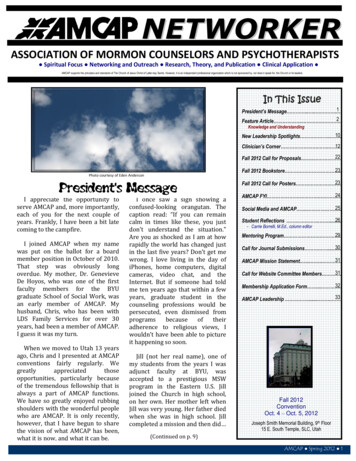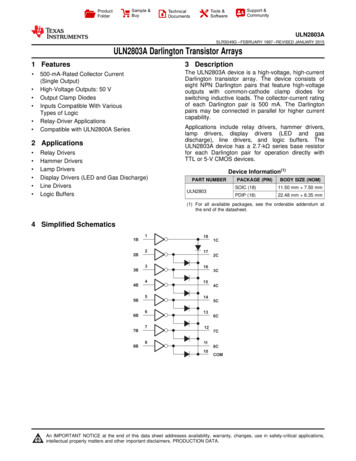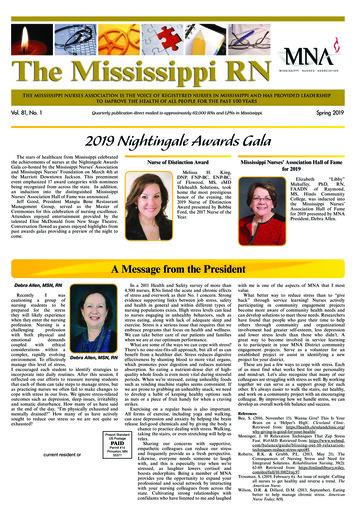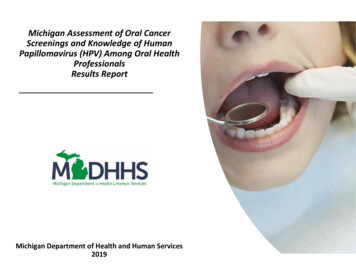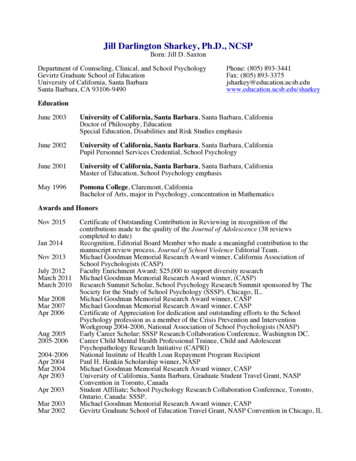
Transcription
Jill Darlington Sharkey, Ph.D., NCSPBorn: Jill D. SaxtonDepartment of Counseling, Clinical, and School PsychologyGevirtz Graduate School of EducationUniversity of California, Santa BarbaraSanta Barbara, CA 93106-9490Phone: (805) 893-3441Fax: (805) csb.edu/sharkeyEducationJune 2003University of California, Santa Barbara, Santa Barbara, CaliforniaDoctor of Philosophy, EducationSpecial Education, Disabilities and Risk Studies emphasisJune 2002University of California, Santa Barbara, Santa Barbara, CaliforniaPupil Personnel Services Credential, School PsychologyJune 2001University of California, Santa Barbara, Santa Barbara, CaliforniaMaster of Education, School Psychology emphasisMay 1996Pomona College, Claremont, CaliforniaBachelor of Arts, major in Psychology, concentration in MathematicsAwards and HonorsNov 2015Jan 2014Nov 2013July 2012March 2011March 2010Mar 2008Mar 2007Apr 2006Aug 20052005-20062004-2006Apr 2004Mar 2004Apr 2003Apr 2003Mar 2003Mar 2002Certificate of Outstanding Contribution in Reviewing in recognition of thecontributions made to the quality of the Journal of Adolescence (38 reviewscompleted to date)Recognition, Editorial Board Member who made a meaningful contribution to themanuscript review process. Journal of School Violence Editorial Team.Michael Goodman Memorial Research Award winner, California Association ofSchool Psychologists (CASP)Faculty Enrichment Award; 25,000 to support diversity researchMichael Goodman Memorial Research Award winner, (CASP)Research Summit Scholar, School Psychology Research Summit sponsored by TheSociety for the Study of School Psychology (SSSP). Chicago, IL.Michael Goodman Memorial Research Award winner, CASPMichael Goodman Memorial Research Award winner, CASPCertificate of Appreciation for dedication and outstanding efforts to the SchoolPsychology profession as a member of the Crisis Prevention and InterventionWorkgroup 2004-2006, National Association of School Psychologists (NASP)Early Career Scholar; SSSP Research Collaboration Conference. Washington DC.Career Child Mental Health Professional Trainee, Child and AdolescentPsychopathology Research Initiative (CAPRI)National Institute of Health Loan Repayment Program RecipientPaul H. Henkin Scholarship winner, NASPMichael Goodman Memorial Research Award winner, CASPUniversity of California, Santa Barbara, Graduate Student Travel Grant, NASPConvention in Toronto, CanadaStudent Affiliate; School Psychology Research Collaboration Conference, Toronto,Ontario, Canada: SSSP.Michael Goodman Memorial Research Award winner, CASPGevirtz Graduate School of Education Travel Grant, NASP Convention in Chicago, IL
Jill D. Sharkey1999-20001995-1996Page 2July 2016Dean’s Fellowship, University of California, Santa BarbaraPomona Scholar, Pomona CollegeCertificationsNov 2003Apr 2003Dec 2000Certification in Non-Violent Crisis InterventionNationally Certified School Psychologist (NCSP), National Association of SchoolPsychologists (renewed through 2015)University of California Human Subjects Protection CertificateAdministrative ExperienceOct 2015Oct 2013Oct 2011Feb 2011Dec 2010Sept 2009Jan 2009Dec 2008Biennial Report, California Commission on Teacher CredentialingBiennial Report, California Commission on Teacher CredentialingSite Visit, California Commission on Teacher CredentialingPreconditions Report, California Commission on Teacher CredentialingBiennial Report, California Commission on Teacher CredentialingProgram Review, NASP, National Recognition-full approval granted Jan 2010Program Review, California Commission on Teacher CredentialingBiennial Report, California Commission on Teacher CredentialingCurrent PositionJuly 2007to presentUniversity of California, Santa BarbaraSanta Barbara, CaliforniaLecturer with Security of Employment (July 2014 to present)Lecturer with Potential Security of Employment (July 2012 to June 2014)Academic Coordinator (July 2007 to June 2012)Independently manages the school psychology credential program. Carries out avariety of research, teaching, supervision, and administrative duties includingsecond- and third-year fieldwork placement and supervision, co-evaluating studentportfolio work in fulfillment of the CCTC PPS Credential, participating in therecruitment of masters and doctoral students, advising and mentoring students,maintaining an independent research program, participating in presentations at stateand national professional conferences in collaboration with faculty and students,conducting additional scholarly activities to bring attention to the excellence ofCCSP, and participation in the generation and/or coordination of program funds.Research ExperienceSept 2005University of California, Santa Barbarato Sept 2007 Santa Barbara, CaliforniaAssistant ResearcherMember of the research faculty at the Center for School-Based Youth Developmentin the Gevirtz Graduate School of Education–acted as Principal Investigator forseveral grants; mentored Ph.D., M.Ed., and undergraduate students; collaboratedwith faculty mentors and early career scholars across the nation and internationallyon grant development, conference presentation, and manuscript preparation.July 2003University of California, Santa Barbarato Sept 2005 Santa Barbara, CaliforniaPostdoctoral ResearcherSponsored by the Don and Marilyn Gevirtz Funds for Excellence Initiative at theCenter for School Based Youth Development, activities included grant writing, datamanagement/analyses, manuscript preparation, grant coordination, and supervision.
Jill D. SharkeyPage 3July 2016Sept 1999University of California, Santa Barbarato June 2003 Santa Barbara, CaliforniaGraduate Research Assistant - NEW VISTASParticipated in the evaluation of a neighborhood-based, family-centered treatmentimplemented in collaboration with the Santa Barbara County Juvenile JusticeCoordinating Council. Tasks included semi-annual report, standardized assessmentdevelopment, community data collection, family data entry/management/analysis,conference presentation, and family interviews.Sept 1996Oregon Social Learning Centerto June 1999 Eugene, OregonDatabase Manager - Linking the Interests of Families and Teachers (LIFT; 9/98 - 6/99)Tracked families and assessments on database, monitored data entry, and providedsupport and training for assessors.Behavioral Support Specialist - Treatment Foster Care (7/98 - 6/99)Social skills trainer for youths with behavioral and emotional disorders in treatmentfoster care. Developed, implemented, and monitored behavior managementprograms in school, home and community settings.Assessor/Interviewer - Female Delinquency (9/97 - 6/99)Assessed delinquent adolescent girls, their families and caretakers in order todetermine the relationship between treatment foster care and outcome.Assessor/Interviewer - New Opportunities Evaluation (9/97 - 6/99)Regularly contacted families to assess their satisfaction with the New OpportunitiesProgram, a nationwide effort to provide assistance to children and their familiesusing a Family Support Worker to coordinate wraparound services.Data Manager - Foster Care Pilot (9/97 - 6/99)Tracked, checked, and ran SPSS syntax on data.Assessor/Interviewer - LIFT (9/96-6/98)Administered an interview, problem solving task and questionnaires to families in astudy to prevent conduct disorders and antisocial behavior in at-risk children. Dutiesalso included data entry and verification.Oct 1996Oregon Research Instituteto Sept 1997 Eugene, OregonResearch Technician - Center for Community Interventions on ChildrenManaged data for several projects under CCIC with the goal of assessing programsto prevent the development of behavioral risk factors and adolescent tobacco use.Duties involved data tracking, data entry, and family contact.Sept 1995Pomona Collegeto May 1996 Claremont, CaliforniaPrincipal Investigator, Senior ThesisDesigned and conducted senior thesis experiment on the correlation between socialanxiety and family factors such as attachment and parenting.
Jill D. SharkeyPage 4July 2016University Teaching ExperienceJan 2004to PresentUniversity of California, Santa BarbaraSanta Barbara, CaliforniaLecturer: Counseling, Clinical, and School Psychology ProgramCNCSP209: Research Practicum (FWS 2007-present)Lead research team with advisees to develop or conduct an ongoing research study.Mentor students in the process of planning and carrying out a research program.CNCSP275: Internship in School Psychology (FWS 2007-present)I supervise internship-level fieldwork experience in the school setting. Each studentobtains direct supervision of a credentialed school psychologist in the fieldworksetting. I provide additional supervision and oversightCNCSP274D-F: School Psychology Fieldwork–Year 2 (FWS 2007-present)ED268B: School Psychology Fieldwork–Year 2 (FWS 2006-2007)Supervise intensive training of students at school sites who also receive supervisionfrom a credentialed school psychologist. I designed the course curriculum for studentsto exceed California Commission on Teacher Credentialing and National Associationof School Psychologists standards.CNCSP290: Seminar in Professional Psychology (Winter 2008)Co-designed this seminar to provide training and experience to implement solutionfocused counseling in the schools and research strategies to evaluate its efficacy.ED 263B Consultation in the Schools and Community (Spring 2005)Provided training in the knowledge and skills necessary to successfully serve as aconsultant in a variety of settings with special emphasis on the school context.ED 266B Cognitive Assessment in Professional Psychology (Fall 2004)I taught students to administer and interpret tests of cognitive abilities. I emphasizedthe relation between clinical assessment tools and theories of intelligence.Ed264D: Psychoeducational Strategies in the Schools (Winter 2004)Reviewed prevention and intervention strategies for students with academic,emotional, and/or behavioral difficulties. I taught strategies at academic, social,personal, school, and family levels with attention to processes and challenges ofimplementation. Effectiveness and evaluation issues were an integral focus.Sept 2001University of California, Santa Barbarato June 2003 Santa Barbara, CaliforniaGraduate Student Teaching AssistantEd266E Child and Adolescent Assessment: Strengths and Contexts(Spring 2003)Examined issues in the assessment of children and adolescents in school andcommunity settings. Focused on understanding contexts that contribute to positiveyouth development: early childhood cognitive, emotional development, risk-relatedbehavior, personal strengths and assets, school safety, violence and school climate.
Jill D. SharkeyPage 5July 2016Ed223E: Psychoeducational Assessment (Winter 2003)Focused on the assessment of core academic skills, this course is designed tointroduce various procedures that can be used to assess academic achievement andpsycho-perceptual processes associated with successful learning.Ed 266D: Behavioral and Emotional Assessment of Children and Adolescents(Fall 2002)Reviewed a variety of assessment procedures related to developing a betterunderstanding of the social and emotional development of children and adolescents. Imentored students to select procedures to include in a comprehensive assessment andsynthesize information into an integrated report and follow-up plan.Ed 262: Seminar on Professional Psychology (Fall 2001 - Spring 2002)Targeting school psychology credential students, this year-long course providesintroductory experiences to develop professional behavior and competencies andimpart crucial information regarding ethics and law pertaining to school psychology,the assessment process, and classroom and school systems.Practitioner ExperienceJuly 2002Santa Barbara Elementary School Districtto June 2007 Santa Barbara, CaliforniaSchool PsychologistSchool Psychologist for two elementary schools. Duties included managing 504accommodation plans, assessment for special education, designated instructionalservices such as counseling, behavior plans, individualized education plans, teacherconsultation, and student/family support.Aug 2001Santa Barbara Elementary School Districtto June 2002 Santa Barbara, CaliforniaSchool Psychology InternIntern in a school psychology position conducting psychoeducational assessment,group and individual DIS counseling, consultation, behavioral plans, individualizededucation plans, teacher consultation, and student/family support.Sept 2000June 2001Carpinteria School DistrictCarpinteria, CaliforniaSchool Psychology PracticumPerformed the duties of a School Psychologist with indirect supervision, includingpsychoeducational assessment, group and individual counseling, consultation,behavioral plans, individualized education plans, and student and family support.Summer2000Hillside HouseSanta Barbara, CaliforniaPsychological InternCompleted psychological evaluations for adults with mental and physical handicapssevere enough to mandate residential care.Summer2000Santa Barbara County Special Education Local Plan AreaCarpinteria, CaliforniaInstructional AideInstructed students with Autism and/or speech and language disorders.
Jill D. SharkeyPage 6July 2016Oct 1999Adams Elementary School, Santa Barbarato June 2000 Santa Barbara, CaliforniaTeacher’s Aide - First Year PracticumLed group projects and one-on-one tutoring for art projects, reading fluency, andmath problems. Developed and co-led a social-skills group for fifth grade girls.June 1997Womenspaceto June 1998 Eugene, OregonCrisis Worker (Volunteer)Fielded domestic violence crisis line calls and monitored the Kidspace play room.SummersChildren’s Health Council1995 & 1996 Palo Alto, CaliforniaSpecial Education Teaching AssistantAided in the education and behavioral intervention of 12-18 year old adolescentswith behavioral, emotional and physical disabilities.Sept 1995Claremont High Schoolto May 1996 Claremont, CaliforniaCounselor (Internship Program)Counseled high school girls covering life issues such as family relationships andfuture choices. Weekly meetings with the school psychologist guided the sessions.ConsultationJune 2016To presentResiliency Interventions for Sexual Exploitation (RISE) Program EvaluationSanta Barbara, CAEvaluatorConsult with and implement the evaluation of RISE for the Santa Barbara CountyDepartment of Behavioral Wellness. RISE is funded through an innovationsgrant from the California Mental Health Services Act to provide intensiveservices to female victims of commercial sexual exploitation of children.June 2015to presentAlcohol and Drug Prevention Strategic Plan Outcomes EvaluationSanta Barbara, CAEvaluatorConsult with Santa Barbara County Department of Behavioral Wellness(formerly Santa Barbara County Alcohol, Drug, and Mental Health) – Alcoholand Drug Program for their Strategic Prevention Plan’s Implementation.January 2009 Santa Barbara County Probation Departmentto presentSanta Barbara, CAConsultantProvide ongoing consultation on the Santa Barbara Assets and Risks Assessment(SBARA), a juvenile risk assessment tool that helps with supervision and treatmentdecision-making. Services include training and local norming.April 2010Challenger Memorial Youth Centerto June 2010 Lancaster, CaliforniaExpert, Multidisciplinary TeamWorked under an agreement with Plaintiffs (American Civil Liberties Union ofSouthern California and Public Counsel) and the Defendants (Los Angeles CountyOffice of Education and Los Angeles County Probation Department) to provideservices in the Agreement Regarding Stay of Litigation in Casey A. v. Robles, No.CV-10-192 (C.D. Cal.). Developed a plan to transform the education program bydeveloping an action plan to improve rehabilitation services.
Jill D. SharkeyPage 7July 2016PublicationsRossi, G., Lenzi, M., Sharkey, J. D., Vieno, A., & Santinello, M. (in press). Factors associated withcivic engagement in adolescence: The effects of neighborhood, school, family, and peercontexts. Journal of Community Psychology.Lenzi, M., Furlong, M. J., Dowdy, E., Sharkey, J. D., & Gini, G. (2015). The combination andvariety of psychological and social assets associated with adolescent victimization: Theconfiguration protective model. Psychology of Violence, 5, 411-421.sMayworm, A. M., Sharkey, J. D., sHunnicutt, K. L., & sScheidel, K. C. (in press). Teacherconsultation to enhance implementation of school-based restorative justice. Journal ofEducational and Psychological Consultation.sLau, W-F. K., sOrtega, K., & Sharkey, J. D. (2015) Disability awareness training with a group ofadolescents with learning disabilities. Contemporary School Psychologist, 19, 145-156.Lenzi, M., Sharkey, J. D., Vieno, A., sMayworm, A. M., sDougherty, D., & Nylund-Gibson, K.(2015). Adolescent gang involvement: The role of individual, family, peer, and schoolfactors in a multilevel perspective. Aggressive Behavior, 41, 386-397.Lenzi, M., sDougherty, D., Furlong, M. J., Sharkey, J. D., & Dowdy, E. (2015). The configurationprotective model: Factors associated with adolescent behavioral and emotional problems.Journal of Applied Developmental Psychology, 38, 49-59.Sharkey, J. D., sRuderman, M. A., sMayworm, A. M., Green, J. G., Furlong, M. J., sRivera, N., &sPurisch, L. (2015). Psychosocial functioning of bullied youth who adopt versus deny thebullied victim label. School Psychology Quarterly, 30, 91-104.sMayworm, A. M., & Sharkey, J. D. (2015). Styles of teaching. In W. G. Scarlett (Ed.). The SAGEEncyclopedia of Classroom Management. (791-794). Thousand Oaks, CA: Sage.Sharkey, J. D., & sHunnicutt, K. (2015). Discipline: School and classroom. In W. G. Scarlett (Ed.).The SAGE Encyclopedia of Classroom Management. (259-262). Thousand Oaks, CA: Sage.sStein, R., & Sharkey, J. D. (2015). Corporal punishment. In W. G. Scarlett (Ed.). The SAGEEncyclopedia of Classroom Management. (193-194). Thousand Oaks, CA: Sage.Sharkey, J. D., sStifel, S. W. F., & sMayworm, A. M. (2015). How to help me get out of a gang:Youth recommendations to family, school, community, and law enforcement systems.Journal of Juvenile Justice, 4, 64-83.sStein, R., & Sharkey, J. D. (2015). Your hands are (not) tied: School-based ethics when parentsrevoke special education consent. Psychology in the Schools, 52, 168-180.Sharkey, J. D., sHunnicutt, K. L., & Furlong, M. J. (2015). Adolescent homicide. In T. P. Gullotta,R. W. Plant, & M. A. Evans (Eds.), Handbook of Adolescent Behavioral Problems:Evidence-Based Approaches to Prevention and Treatment–Second Edition. (515-537). NewYork: Springer. ––Peer Reviewed.Sharkey, J. D. (Winter 2014). Book Review: Is everyone hanging out without me? (And otherconcerns). School Psychology: From Science to Practice to Policy, 7(4), 10.sStudent mentee
Jill D. SharkeyPage 8July 2016Lenzi, M., Vieno, A., Sharkey, J. D., sMayworm, A. M., Scacchi, L., Pastore, M., & Santinello, M.(2014). How schools can teach civic engagement besides civic education: The role ofdemocratic school climate. American Journal of Community Psychology, 54, 251-261.Holt, M. K., Green, J. G., Reid, G., Dimeo, A., Espelage, D. L., Felix, E., Furlong, M. J., Poteat, P.,& Sharkey, J. D. (2014). Association between past bullying experiences and initialadjustment to college. Journal of American College Health, 62, 552-560.Nyborg, V., Sharkey, J. D., Furlong, M. J. (2014). Homicide during adolescence. In T. P. Gullotta& M. Bloom (Eds.). Encyclopedia of primary prevention and health promotion. (12611270). New York: Springer. ––Peer Reviewed.Felix, E. D., Greif Green, J., & Sharkey, J. D. (2014). Best practices in bullying prevention. In P.L. Harrison & A. Thomas (Eds.), Best Practices in School Psychology: Systems–LevelServices. (245-258). Bethesda, MD: National Association of School Psychologists. ––PeerReviewed.sMayworm, A., & Sharkey, J. D. (2014). Ethical considerations in a three-tiered approach to schooldiscipline policy and practice. Psychology in the Schools, 51, 693-704.sTwyford, J., Dowdy, E., & Sharkey, J. D. (2014). Implications of self-reported levels of hope inLatino and Latina youth on probation. Journal of Juvenile Justice, 3(2), 72-82.Sharkey, J. D., sHunnicutt, K. L., sMayworm, A. M., sSchiedel, K. C., & sCalcagnotto, L. (2014).Effective yard supervision: From needs assessment to customized training. ContemporarySchool Psychologist, 18, 103-116Sharkey, J. D., Quirk, M., & sMayworm, A. M. (2014). Student engagement. In M. J. Furlong, R.Gilman, & E. S. Huebner (Eds.). Handbook of Positive Psychology in the Schools (176191). New York: Routledge/Taylor & Francis. ––Peer Reviewed.sMayworm, A., Sharkey, J. D., & Parker, R. (2013). School discipline styles and studentperceptions of school safety: A latent class analysis. CASP Today, 63(4), 6-9.sMayworm, A., & Sharkey, J. D. (2013). Gender-specific mental health outcomes of a communitybased delinquency intervention. Journal of Juvenile Justice, 3, 15-35.Dowdy, E. sTwyford, J., & Sharkey, J. D. (2013). Methods of assessing behavior I: Observationsand rating scales. In D. H. Saklofske, C. R. Reynolds, & V. L. Schwean (Eds.). OxfordHandbook of Psychological Assessment of Children and Adolescents (623-650). New York:Oxford University Press. ––Peer Reviewed.Dowdy, E., Furlong, M. J., & Sharkey, J. D. (2013). Using surveillance of mental health toincrease understanding of youth involvement in high risk behaviors. A value added analysis.Journal of Emotional and Behavioral Disorders, 21, 33-44.Morrison, G. M., Sharkey, J. D., You, S., Felix, E. D., & sGriffiths, A. J. (2013). Mediation ofschool bonding and peer norms on the reciprocal effects of friend victimization and problembehavior. School Psychology International, 34, 101-120.Green, J. G., Felix, E. D., Sharkey, J. D., Furlong, M. J., & Kras, J. E. (2013). Identifying bullyvictims: Definitional versus behavioral approaches. Psychological Assessment, 25, 651-657.sStudent mentee
Jill D. SharkeyPage 9July 2016Sharkey, J. D., & Fenning, P. A. (2012). Special issue: Designing school contexts in support ofproactive discipline: Applications to school violence. (Guest Editors). Journal of SchoolViolence, 11, 95-186.Sharkey, J. D., & Fenning, P. A. (2012). Rationale for designing school contexts in support ofproactive discipline. Journal of School Violence, 11, 95-104.You, S., & Sharkey, J. D. (2012). Advanced mathematics coursetaking: A focus on genderequifinality. Learning and Individual Differences, 22, 484-489.Fenning, P., & Sharkey, J. D. (2012). Addressing discipline disproportionality with systemicschoolwide approaches. In A. L. Noltemeyer, & C. S. McLoughlin(Eds.), Disproportionality in education and special education (199-213). Springfield,IL: Charles C. Thomas. ––Peer Reviewed.Fenning, P., & Sharkey, J. D. (2012). Creating equitable school policies to prevent and addressethnic disproportionality in school discipline practices. In A. L. Noltemeyer, & C. S.McLoughlin (Eds.), Disproportionality in education and special education (237-258).Springfield, IL: Charles C. Thomas. ––Peer Reviewed.Sharkey, J. D., Dowdy, E., sTwyford, J., & Furlong, M. J. (2012). An overview of measurementissues in school violence and school safety research. In S. R. Jimerson, A. B. Nickerson, M.J. Mayer, & M. J. Furlong (Eds.), The Handbook of School Violence and School Safety:International Research and Practice. (259-272). New York: Routledge.––Peer Reviewed.Sharkey, J. D., Furlong, M. J., Dowdy, E., Felix, E. D., sGrimm, L., & sRitchey, K. (2012). TheUnited States Safe Schools/Healthy Students Initiative: Turning a national initiative intolocal action. In S. R. Jimerson, A. B. Nickerson, M. J. Mayer, & M. J. Furlong (Eds.), TheHandbook of School Violence and School Safety: International Research and Practice.(487-502). New York: Routledge.––Peer Reviewed.Furlong, M. J., Sharkey, J. D., Quirk, M., & Dowdy, E. (2011). Exploring the protective andpromotive effects of school connectedness on the relation between psychological health riskand problem behaviors/experiences. Journal of Educational and Developmental Psychology,1(1), 18-34.Sander, J. B., Sharkey, J. D., sGroomes, A. N., sKrumholz, L. L., sWalker, K., & sHsu, J. Y. (2011).Social justice and juvenile offenders: Examples of fairness, respect and access in educationalsettings. Journal of Educational and Psychological Consultation, 21, 309-337.sTanigawa, D. A., Furlong, M. J., Felix, E. D., & Sharkey, J. D. (2011). The protective role ofperceived social support against the manifestation of depressive symptoms in peer victims.Journal of School Violence, 10, 393-412.sShekhtmeyster, Z., Sharkey, J. D., & You, S. (2011). The influence of multiple ecological assetson substance use patterns of diverse adolescents. School Psychology Review, 40, 386-404.Sharkey, J. D. (2011). Taking the SBARA-2 to Ventura and beyond. Probation Today, 7(6), 1. –Newsletter.sStudent mentee
Jill D. SharkeyPage 10July 2016Felix, E. D., Sharkey, J. D., Green, J. G., Furlong, M., F., & sTanigawa, D. (2011). Getting preciseand pragmatic about the assessment of bullying: The development of the California BullyingVictimization Scale. Aggressive Behavior, 37, 234-247.Sander, J. B., Sharkey, J. D., sFisher, A. L., sBates, S., & sHerren, J. A. (2011). School policies,academic achievement and general strain theory: Applications to juvenile justice settings.Journal of Juvenile Justice, 1, 27-40.Sharkey, J. D., sShekhtmeyster, Z., sChavez-Lopez, L., sNorris, E., & sSass, L. (2011). Theprotective influence of gangs: Can schools compensate? Aggression and Violent Behavior,16, 45-54.Sander, J. B., Sharkey, J. D., sOlivarri, R., sTanigawa, D., & sMauseth, T. (2010). A qualitativestudy of juvenile offenders, student engagement and interpersonal relationships:Implications for research directions and preventionist approaches. Journal of Educationaland Psychological Consultation, 20(4), 1-28.Sharkey, J. D., Sander, J. B., & Jimerson, S. R. (2010). Acculturation and mental health: Responseto a culturally-centered delinquency intervention. Journal of Criminal Justice, 38, 827-834.Furlong, M. J., Sharkey, J. D., Felix, E. D., sTanigawa, D., & Greif-Green, J. (2010). Bullyingassessment: A call for increased precision of self-reporting procedures. In S. R. Jimerson, S.M. Swearer, & D. L. Espelage (Eds.), The International Handbook of School Bullying. (329346). New York: Routledge. ––Peer Reviewed.Sharkey, J. D., You, S., Morrison, G. M., & sGriffiths, A. J. (2009). Behavioral and EmotionalRating Scale-2 Parent Report: Exploring a Spanish Version with At-Risk Students.Behavioral Disorders, 35(1), 53-65.You, S., & Sharkey, J. D. (2009). Testing a developmental-ecological model of studentengagement: A multilevel latent growth curve analysis. Educational Psychology, 29(6), 659684.sGriffiths, A. J., Sharkey, J. D., Furlong, M. J. (2009). Student Engagement and Positive SchoolAdaptation. In R. Gilman, E. S. Huebner, & M. J. Furlong (Eds.) Handbook of PositivePsychology in the Schools. (197-211). New York: Routledge. ––Peer Reviewed.Sharkey, J. D., You, S., & sSchnoebelen, K. J. (2008). Relations among school assets, individualresilience, and student engagement for youth grouped by level of family functioning.Psychology in the Schools, 45, 402-418.You, S., Furlong, M. J., Felix, E. D., Sharkey, J. D., sTanigawa, D., & Green, J. G. (2008).Relations among school connectedness, hope, life satisfaction, and bully victimization.Psychology in the Schools, 45, 446-460.ssGriffiths, A., Sharkey, J. D., Furlong, M. J. (2008). Targeted threat assessment: Ethicalconsiderations for school psychologists. School Psychology Forum: Research inPractice, 2(2), 30-48.Student mentee
Jill D. SharkeyPage 11July 2016Furlong, M. J., Sharkey, J. D., Boman, P., & Caldwell, R. (2007). Cross-validation of theBehavioral and Emotional Rating Scale-2 Youth Version: An exploration of strengthbased latent traits. Journal of Child and Family Studies, 16, 696-711.Felix, E. D., Furlong, M.J., Sharkey, J. D., Osher, D. (2007). Implication for Evaluating MultiComponent, Complex Prevention Initiatives: Taking Guidance from the Safe School/HealthStudents Initiative. Journal of School Violence, 6(2), 3-22.Furlong, M. J., Sharkey, J. D., Felix, E. D., & Osher, D., (2007) Special issue: SafeSchools/Healthy Students Initiative: Outcomes and legacy. (Guest Editors). Journal ofSchool Violence, 6(2), 1-134.Pyle, S. A., Sharkey, J. D., Yetter, G., Felix, E., Furlong, M. J., & Poston, W. S. (2006). Fightingan epidemic: The role of schools in reducing childhood obesity. Psychology in the Schools,43, 361-376.Sharkey, J. D., Furlong, M. J., & Yetter, G. (2006). An overview of measurement issues in schoolviolence and school safety research. In S. R. Jimerson & M. J. Furlong (Eds.). Handbook ofSchool Violence and School Safety: From Research to Practice. (121-134). Mahwah, NJ:Lawrence Erlbaum Associates. ––Peer Reviewed.Furlong, M. J., & Sharkey, J. D. (2006). A review of methods to assess student self-report ofweapons on school campuses. In S. R. Jimerson & M. J. Furlong (Eds.). Handbook ofSchool Violence and School Safety: From Research to Practice. (235-256). Mahwah, NJ:Lawrence Erlbaum Associates. ––Peer Reviewed.Furlong, M. J., Felix, E. D., Sharkey, J. D., Larson, J. (2005). Preventing school violence: A planfor safe and engaging schools. Principal Leadership, 6(1), 11-15.Furlong, M. J., Nyborg, V. M., Sharkey, J. D. (2005). Homicide. In T. P. Gullotta & G. Adams(Eds.), Handbook of Adolescent Behavioral Problems: Evidence-Based Approaches toPrevention and Treatment. (pp. 543-566). New York: Springer. ––Peer Reviewed.Sharkey, J. D., & O’Farrell, S. L. (2005). Cheating. In S. W. Lee & P. A. Lowe (Eds.),Encyclopedia of School Psychology. (pp. 86-87). Thousand Oaks, CA: Sage. ––PeerReviewed.Jimerson, S. R., Sharkey, J. D., O’Brien, K. M., Furlong, M. J. (2004). The Santa Barbara Assetsand Risks
Pupil Personnel Services Credential, School Psychology June 2001 University of California, Santa Barbara, Santa Barbara, California Master of Education, School Psychology emphasis May 1996 Pomona College, Claremont, California Bachelor of Arts, major in Psychology, concentration in Mathematics Awards and Honors

